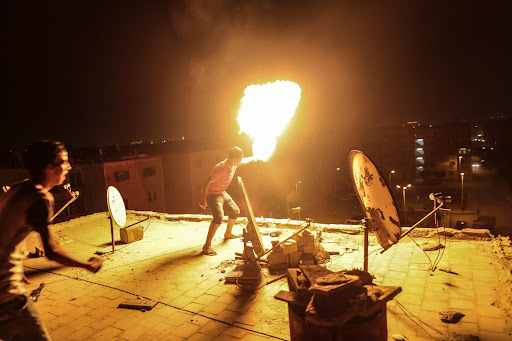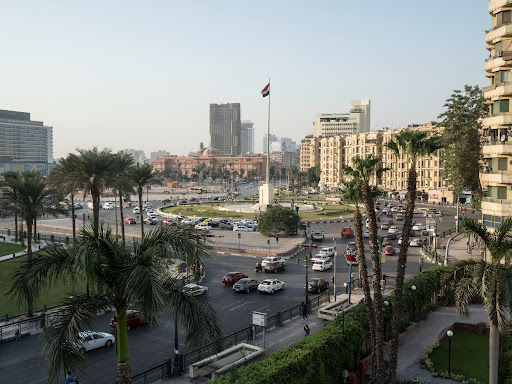A mahraganat performance in a Cairo city street. (Photo: Mosa’ab Elshamy)
When Egypt’s 2011 revolution came, it had its own sound. Past the initial eruption of chants, screams, gunshots, and cheers, there existed a single sustained note of euphoria that, for many, was perfectly encapsulated in songs such as the Cairokee and Wust el-Balad collaboration Sout el Horeya and the entire oeuvre of activist-singer Ramy Essam.
He had been detained and tortured by central security officers in the chaotic 18 days preceding the ouster of President Mohamed Morsi. In that period, Tahrir Square existed as a club of sorts; a clearly defined area with its own border controls and unifying ideology, and multiple platforms for a wide array of musical acts flourishing on and riffing off the commonalities that had united the most disparate of audiences.
Yet, while glossily produced victory ballads and folksy acoustic narratives might have been the sound of the revolution, mahraganat music was the sound of the nation that emerged from it, and the turbulence that followed.
Despite the fact that it had begun to creep into public consciousness before the revolution, it was through the spirit of a nationally unifying event, as well as the across-the-board absence of regulation that followed, which allowed the mahraganat genre to explode the way it did.
Deemed a new sound for a new nation, not intended for any particular venue, but dominating the ones in which it was played, the mahraganat phenomenon saw its performers, who had shaped the genre out of their frustration at being marginalised, lifted to the peak of national cultural exposure.
From Islam Chipsy performing at the European Union ambassador’s residence to an audience of stunned dignitaries in evening wear and Amr Haha’s frequent appearances at house parties hosted by young intellectuals and activists to the soaring attendance at concerts held in the backstreets of their own fringe neighbourhoods, mahraganat performers became symbols of a misjudged youth, the no-good kids that proved their worth by ridding the nation of a tyrant.
 Young men start a fire during a street wedding in the Cairo neighbourhood of Salam City. (Photo: Mosa’ab Elshamy)
Young men start a fire during a street wedding in the Cairo neighbourhood of Salam City. (Photo: Mosa’ab Elshamy)
It left little impression on the older generations because of its abrasiveness of sound and the frankness of its content, whereas younger ones embraced it with all the fervour of a free house for the weekend. Meanwhile, foreigners went crazy over what they interpreted as the sounds of a newly liberated youth.
They were, indeed, liberated youths; although their role in the liberation process remains questionable, with a majority of the rising mahraganat performers being the first to admit that they played little to no part in the events of the revolution.
Despite the connotation thrust upon it, mahraganat was the sound of the extreme political apathy felt by an overwhelming segment of the young Egyptian population — a sound that happened to burst through its bubble as the nation’s institutions caved in on themselves.
The lyrics of this genre were a direct reflection of this, their subjects ranging from sudden loss of one’s footwear to weightier topics like the inability to fulfil swelling sexual urges in the face of social restrictions. Bar a few exceptions, most of which appeared as products of a post-revolutionary trend, the lyrics were rarely political in nature.
It was this definitive apathy, so deeply seated and comprehensive that it constituted — through its lack of interest in, or regard for, an equally unresponsive larger society — a form of rebellion in its own right.
The fact that live performances were not held in ambassadors’ residencies or downtown clubs, but in the back alleys and outer, informal neighbourhoods that originally inspired such furious sounds, showed this.
These concerts were loud and raucous affairs that would feature audiences consisting almost entirely of adolescent males, from teens to young men. They would dance together, in circles around one another or on each other’s shoulders, in a craze induced by the deafening, rapid-fire beats and equally erratic flashing lights bursting from a stage crowded by a group of performers — the headlining act, along with other members of their “crew”. Towards the front of the crowd cellphones are waved through the air; not much further back, thick clouds of smoke are exhaled into it.
Yet, as is the case in the raves of the upper echelon, the drug of choice in this particular scene comes in the shape of a pill. A cheaper alternative to hashish or even low-quality bango, Tramadol is an over-the-counter drug sold as a stimulant that, in the past few years, has spread to a considerable degree among less-privileged classes, where most occupations involve some type of manual labour that demands work in long shifts. With effects such as numbness of body and increased stamina, the drug is also a perfect choice for those wishing to hand themselves over to the relentless force of mahraganat.
Much like the combination of heavy autotune, ear-piercing sirens, distortedly deep bass lines, and synthesised drum rolls sums up a total disregard for any basic rules of musical composition, the concerts in which these sounds were unleashed represented, and celebrated, a total disengagement from the wider cultural and political, scene, and then, a triumph over it — a burst of confidence that was certainly reinforced by the absence of authority that followed the uprising.
 Tahrir Square, as the site of many gatherings during the Egyptian revolution, existed as a club of sorts; a clearly defined area with its own border controls and unifying ideology. (Photo: Andreas Langfeld)
Tahrir Square, as the site of many gatherings during the Egyptian revolution, existed as a club of sorts; a clearly defined area with its own border controls and unifying ideology. (Photo: Andreas Langfeld)
By the time the dust of the revolution settled, and the sense of togetherness fostered by it had faded in the face of growing widespread contention, it became apparent that the varying cultural scenes had been soaked back up from Tahrir Square and into their respective bubbles, but not without souvenirs from a short-lived convergence.
In some cases, this led to hypocritical results, as seen by top-tier clubs like the recently-inaugurated O Bar, and at events organised by Nacelle. Because of the security vacuum following the revolution they would perform Facebook-profile background checks on patrons before granting admission, while simultaneously playing music or inviting performers from the same neighbourhoods and social “classes” that they deemed undesirable, or even, “threatening” to their regular clientele. As a result, the sounds resulting from decades of social divide became new entries on the playlists danced to by members of the one percent.
In other spaces, such as Prince 2 in Giza’s Mohandessin district, a different sort of dissonance could be seen. This mirror-walled venue, which exists after hours in an otherwise wholesome commercial shopping mall in the heart of a middle-class suburb, is an example of the profit-friendly, anything-goes approach of post-revolutionary Egypt. As made clear by its 52-year-old female manager, Madame Warda, in her proudly stated observation “after the revolution, there is nobody to say no anymore”, the venue is a recreation of the Al-Haram Street underground, albeit one taken to further extremes. This can be seen in at least two, clearly underaged, androgynously dressed sex workers being present, even under the surveillance of staff.
Occupying store space in a relatively tiny mall, the venue is a small one, its non-elevated “stage” area extending between sets of tables and steel, thin cushioned seats. The windows of this second-storey venue, which would otherwise offer a view of a busy intersection and residential balconies — not to mention offering the outside world a peek in — are blacked out with sheets of children’s stickers; the Mickey Mouse and SpongeBob faces staring outwards.
With the further precaution of thick curtains, as well as a lack of proper ventilation, the abundant smoke from shishas, cigarettes and joints hangs heavily in the air and coats all surfaces; an added haze through which to observe a series of galloping, graceless belly dancers as they move to a setlist of all the familiar sounds, together with added elements of the mahraganat fad, as well as post-revolutionary anthems celebrating new, hard-won freedoms.
Ten Cities (Spector Books/Goethe-Institut), a book on clubbing in Nairobi, Cairo, Kyiv, Johannesburg, Naples, Berlin, Luanda, Lagos, Bristol and Lisbon between 1960 and March 2020, is edited by Johannes Hossfeld Etyang, Joyce Nyairo and Florian Sievers. This extract, on the emergence of mahraganat in Cairo, is the second in a series of 10 weekly excerpts from the book.